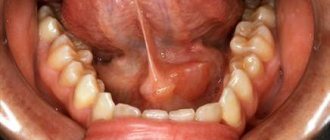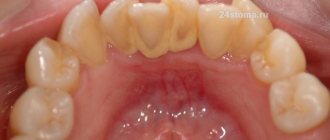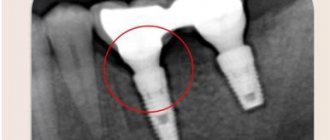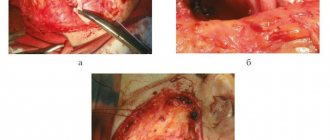Causes of the disease
A number of factors can provoke the manifestation of the disease, which include various influences from the outside world. Any patient can encounter this, even with good oral hygiene.
Main causes of the disease:
- pathogenic microorganisms that have entered the patient’s oral cavity;
- some viral diseases;
- toxic substances contained in food.
Another reason for the formation of salivary gland adenoma is considered to be an addiction to smoking tobacco. Smoke that enters the body contains many carcinogens that damage the glandular epithelium of the salivary glands. As a result, protective mechanisms are activated, which provokes increased cell division, resulting in the formation of an adenoma.
Types of salivary gland adenoma
Adenoma is characterized by slow growth, so the patient may not even be aware of the existence of this disease in his body for decades. Many people discover the presence of the disease only when undergoing examinations for other problems, or during a routine examination. Rapid tumor growth indicates its malignant degeneration.
Classification:
- Polymorphic or pleomorphic . It is a dense encapsulated node containing light fluid, lymphoid cells and fibroblasts.
- Basal cell . It is a small, clearly demarcated node, the structure is dense, uniform, grayish-whitish or brownish in color. May be multiple.
- Canalicular . It is distinguished by the content of prismatic epithelial cells, which are collected in thin bundles.
- Greasy. This is a clearly demarcated tumor formed from different shapes and sizes of sebaceous cells, with cystic changes. The surface has a grayish-whitish or yellow color. There is no danger of relapse.
- Adenolymphoma . The tumor is mobile, contains lymph, is benign, and consists of glandular epithelial structures.
- Monoform. It consists of large cells with eosinophilic granular cytoplasm and a small dark nucleus, and is light in color.
- Adenocarcinoma . A malignant epithelial tumor develops in the large and small salivary glands, has proliferation of the epithelium in ductal formations in the form of papillary, cribriform, tubular structures. The prognosis is unfavorable.
The most common type of salivary gland adenoma by location is the parotid. Adenomas of the submandibular glands, small glands and sublingual glands are also isolated. Regardless of the location of the tumor, the only way to treat the disease is to remove the adenoma.
Pleomorphic adenoma
What is pleomorphic adenoma?
Pleomorphic adenoma is the most common type of salivary gland tumor.
Most tumors begin in one of the major salivary glands (parotid or submandibular glands), although this type of tumor can also be found in the skin and lungs. Pleomorphic adenomas are slow-growing tumors, although they can reach large sizes without treatment. Most pleomorphic adenomas are benign tumors. However, they may grow back in the same location if they are not removed completely.
Salivary glands
When we chew food, our body secretes a liquid called saliva into our mouth. Saliva is important because it contains chemicals that help with digestion. Saliva is produced by organs called salivary glands, which are located throughout the head and neck.
Most people have three main salivary glands and many minor salivary glands. The main salivary glands are called the parotid, submandibular and sublingual glands. The minor salivary glands are very small, and there are so many of them that they are not given proper names. Most of the minor salivary glands are located in the mouth.
The parotid gland is the largest salivary gland and can be found on the side of the face just in front of the ear. The submandibular gland is located just below the lower jaw at the top of the neck. The sublingual gland is the smallest of the major glands and can be found under the tongue.
The salivary glands are made up of small groups of cells called glands that are connected to the inside of the mouth by long, thin channels called ducts. The glands produce chemicals in saliva, which travels through ducts into the mouth.
Carcinoma, ex-pleomorphic adenoma
In rare cases, cancer develops from a pleomorphic adenoma. These tumors are called ex-pleomorphic adenoma carcinoma, which medically means "cancer arising from a pleomorphic adenoma." Tumors that are very large, have been around for many years, or have come back several times have a higher risk of developing cancer. Because a pleomorphic adenoma can turn into cancer over time, it is recommended that all pleomorphic adenomas be completely removed.
How do pathologists make this diagnosis?
A diagnosis of pleomorphic adenoma is usually made after a small sample of tissue is removed from your body through a procedure called a biopsy. The tissue is then sent to a pathologist, who examines it under a microscope. A test called immunohistochemistry may be performed to confirm the diagnosis.
Most patients with pleomorphic adenoma will be offered surgery to remove the tumor. The tumor will then be sent to a pathologist who will prepare a new pathology report. This report will confirm or revise the original diagnosis and provide additional important information such as tumor size.
When examined under a microscope, most pleomorphic adenomas are composed of a combination of cells found in a normal salivary gland. However, unlike the orderly arrangement of cells in a normal gland, tumor cells are disorganized and do not form normal ducts or glands.
The tumor cells are surrounded by connective tissue called stroma, which in pleomorphic adenoma often appears blue or gray under the microscope. Pathologists describe this type of stroma as chondromyxoid or myxochondroid. The tumor is often surrounded by a thin layer of tissue called the tumor capsule. The capsule separates the tumor from the normal surrounding salivary gland tissue.
What to look for in your report after tumor removal
Tumor size
This is the size of the tumor in centimeters (cm). The tumor is usually measured in three dimensions, but your report only describes the largest dimension. For example, if the tumor measures 4.0 cm by 2.0 cm by 1.5 cm, your report will describe a tumor measuring 4.0 cm.
Fields
A margin is any tissue that has been cut by a surgeon to remove a tumor from your body. The types of fields described in your report will depend on the agency involved and the type of transaction performed.
A negative margin means that no tumor cells were observed on any of the cut edges of the tissue. The limit is called positive if the tumor cells are at the very edge of the cut tissue. A positive margin is associated with a higher risk of tumor recurrence at the same site after treatment.
The fields will only be described on your report after all of the tumor has been removed. However, many pathologists will not describe the margins of a pleomorphic adenoma in the pathology report if they are negative.
Lymph node
Lymph nodes are small organs located in different parts of the body. They are part of the body's immune surveillance system. When tumor cells enter a lymph node, it is called a lymph node. metastasis.
Lymph nodes around the tumor are often removed at the same time as the tumor. Your pathologist will examine each of these lymph nodes under a microscope to see if they contain any tumor cells.
Tumor cells of pleomorphic adenoma rarely enter the lymph node. If tumor cells are found in a lymph node, your pathologist will examine them to see if they have changed to look more like cancer cells or still look like pleomorphic adenoma cells.
Jason Wasserman, MD, FRCPC (updated August 22, 2022)
Treatment
Removal of a salivary gland adenoma is a simple surgical operation; the prognosis for treatment in most cases is favorable. The only difficulty that can be encountered during treatment is damage to the facial nerve. However, a solution has been found for this problem.
To gain access to the tumor, the surgeon dissects the facial nerve by carefully lifting it upward. Only after this the tumor is removed. Removal of the node is carried out within a few minutes in the maxillofacial departments of dental clinics. If the results of histological analysis of the tissues of the removed tumor confirm its benign nature, no additional treatment will be required.
Diagnosis of the disease
Colonoscopy is the gold standard for diagnosing the disease. It allows you to examine the entire surface of the intestine using special light filters and vital staining methods.
Detection of serrated adenomas requires a good bowel cleansing. In comparison, a satisfactory level of training is sufficient to diagnose ordinary adenomatous polyps. As we have already noted, serrated neoplasms can easily be mistaken for an ordinary fold of the intestinal mucosa, so this requires not only high-quality cleaning of the intestinal wall, but also special vigilance and research technique. In particular, the likelihood of detecting such formations is influenced by the speed at which the colonoscope is withdrawn. 9 minutes is considered optimal. In addition, various additional options are used:
- Inspection in autofluorescence mode.
- Inspection in white light.
- Narrow spectrum inspection.
- Chromoscopy with indigo carmine, methylene blue, crystal violet.
The final diagnosis is established after a morphological study of the removed polyp or its biopsy material.
Complications
Despite the fact that treatment of salivary gland adenoma does not pose a serious problem, it is important to remember that untimely removal of the tumor can lead to a number of complications. The most serious of them is the transformation of a benign neoplasm into a malignant one. Unlike malignant tumors, salivary gland adenoma can exist asymptomatically, only in some cases causing facial asymmetry. Therefore, if you detect the slightest swelling, you must immediately consult a doctor. Timely removal of the tumor will prevent many very unpleasant problems.
The most common postoperative complications:
- the risk of developing Frey's syndrome (occurs when autonomic nerve fibers are damaged, accompanied by redness and sweating of the operated area of the face);
- a feeling of dry mouth when the gland is completely removed.
Observation and regular consultations with a doctor can reduce all postoperative complications to a minimum.
Complications in the presence of serrated adenoma
The main danger of serrated adenomas is the possibility of their malignant transformation into cancer. Until a few decades ago, it was believed that colorectal malignancies develop only from adenomatous polyps. Accordingly, it was recommended to simply observe villous neoplasms. But later it turned out that these tumors can also degenerate into cancer, and have their own, unique path of carcinogenesis. The larger the size of the polyp and the longer it exists, the higher the risks of malignant transformation. The most dangerous in this regard are large, long-existing neoplasms on a wide base.











